System Synthetics
In collaboration with Kluyver Centre for Genomics of Industrial
System Synthetics
In collaboration with Kluyver Centre for Genomics of Industrial
The possibilities of production of the bio fuel out of the degradation process of the plastic waste
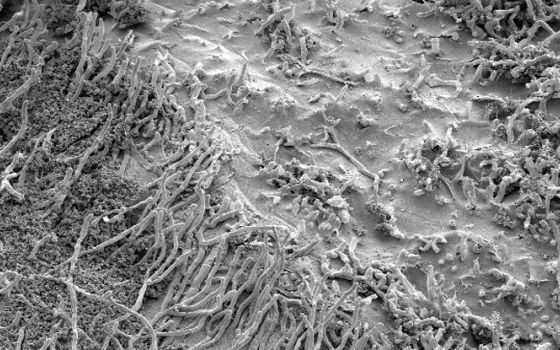
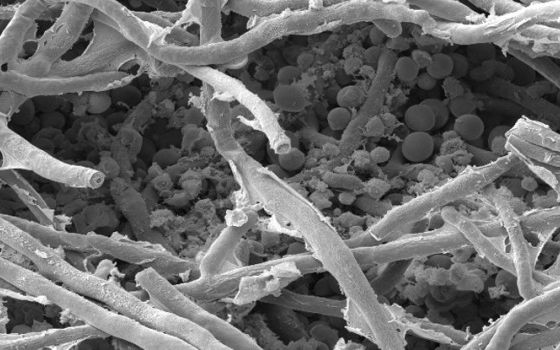
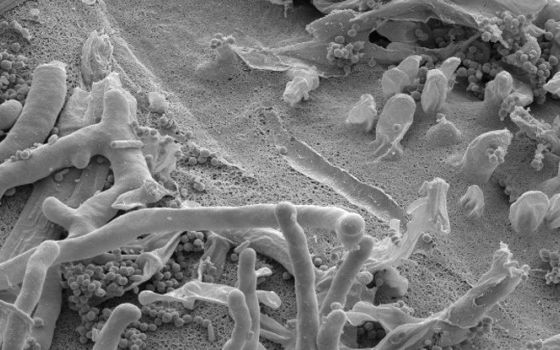
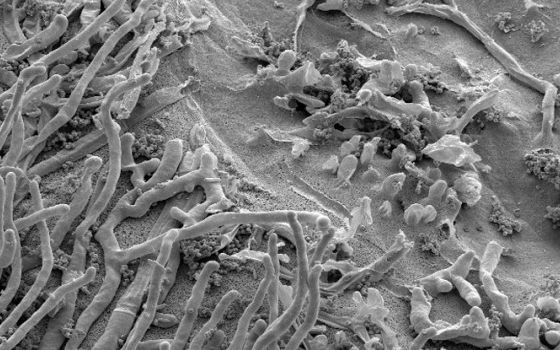
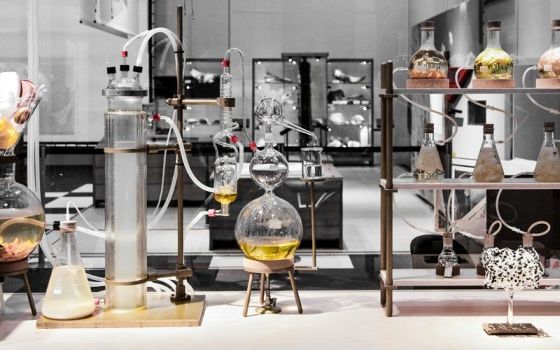
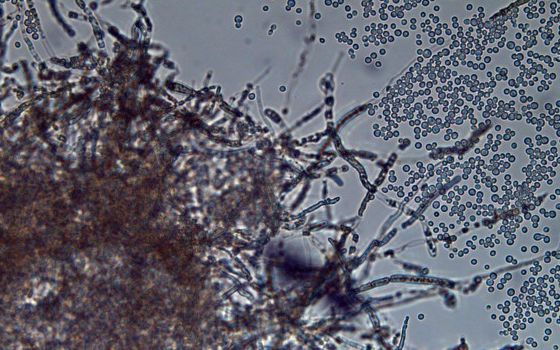

Maurizio Montalti - System Synthetics
Maurizio Montalti - System Synthetics
Maurizio Montalti - System Synthetics
Maurizio Montalti - System Synthetics
Maurizio Montalti - System Synthetics
Maurizio Montalti - System Synthetics
Maurizio Montalti - System Synthetics
Fermentation created their project System Synthetics in order to study the possibilities of production of the bio fuel out of the degradation process of the plastic waste. In this scenario one of the two fungi (filamentous fungus) would break down plastic waste and the other fungus (yeast) would produce bio-ethanol out of it. This enables the public to research more about the alternatives for fossil fuels.
Posted on 15/06/2011
Chimera of the ecofuture
Designer Maurizio Montalti cooperated with the Kluyver Centre for Genomics of Industrial Fermentation in order to study the possibilities of production of the bio fuel out of the degradation process of the plastic waste. In this scenario one of the two fungi (filamentous fungus) would break down plastic waste and the other fungus (yeast) would produce bio-ethanol out of it. It may sound easy to us, but in fact it is a really complicated biotechnological procedure that can take years to accomplish because it includes the creation of a new organism. Though we don’t know when the final goal will be accomplished, when this finally happens, it will definitely have the potential of improving our waste-based society. Furthermore, we have to emphasize the interesting correlation between different aspects of design included in this project: on the one hand there is a classic design of the object (bioreactor) and on the other there is a design and construction of a new biological system not found in nature. The designer becomes the creator of both living and non-living thing, and because of that the installation gets new annotations concerning the aesthetics. In order to find out more about this interesting project and it’s possibilities we will put a few questions to designer Maurizio Montalti and scientist Han Wösten from the Kluyver Centre.
Maurizio Montalti
Hello, Maurizio, can you, please, tell me more about your project and whether you have achieved your goal?
The project is about the possibility of combining the specific skills of two fungal organisms, which belong to the same kingdom – one filamentous fungs and yeast. The first is found to be capable of degrading plastic materials; it literally feeds on the materials and, by using them as a source of food, it neutralizes the toxic compounds and it transforms them into bio-mass. On the other hand, there is a yeast, a model organism in scientific research, which has been largely exploited over centuries because of its ability to ferment food and drinks. Nowadays fungi are widely studied in the labs as one of the main industrial cell factories for the production of enzymes, antibiotics, etc. and yeasts are tested for the production of bio-ethanol because they in fact consume sugars and produce alcohol and carbon dioxide as waste…So, the initial idea has been to combine these two organisms…The inspiration came from the endosymbiotic theory – it is a process where one microbe takes over another microbe and they get fused together. According to this theory the mitochondria of eukaryotes evolved from aerobic bacteria living within their host cell. So, the humans, who are also eukaryotes, actually originated from two bacteria that somehow got together and got to share the same nucleus. Instead of letting this process develop in a million years, I wanted to influence it by using a man made symbiosis (with the help of synthetic biology) in order to solve one of the major dangers of our contemporary society– the fact that there is more and more plastics in the world. I am not attacking plastics as a bad material, it has a lot of advantages and, luckily, nowadays, there are new methods of productions and new applications already created, but, looking at the old kind of plastics, which we still keep producing largely, we are not completely aware of the heavy burden they put on ecology and ultimately on ourselves. Only during the last 10 or 20 years our eyes have slowly started to open…
As I am informed, scientists haven’t been able to combine these two organisms yet. Was that your idea?
No, they haven’t done it yet. They work on the processes of fermentation in order to produce bio-ethanol from yeast. System Synthetics comes as a direct continuation, or better to say an evolution of my previous project Continuous bodies, where I was triggered by the great opportunity to collaborate with the plastic-breaking fungus. I started experimenting with it, and ten months later I succeeded in degrading some plastic samples. I applied the same way of thinking to the plastic monobloc chair which I took as the icon of disposability and through that I built a provocative image.
And, are you still trying to degrade the chair!?
It is in my studio. The fungus is spread all over the chair, but in order to have the process developing efficiently, it needs to be in laboratory conditions, so that is where the project System Synthetics actually originated from… It was a great possibility to improve the performance of this organism and combine it with a possibilities of another organism…
Also, this project raises questions about potential benefits of man-made evolution represented by genetic modification. I am not expressing my position on this by saying I am pro or against…I just want to highlight our necessity to find the balance by not completely rejecting new technologies. Once we are able to understand the building blocks of life we can take advantage of them to solve our problems. And then, of course, everything, every material for example, can be used in a good or in a bad way, as iron for instance – you can make an iron chair, and you can make a sword from it. It’s up to the individual responsibility and the society to choose how to make the correct use of technologies.
First the man invents plastics and then he has to find a way to destroy it. Quite useless work!
Yes, it is for sure not very clever. If you think about it, plastics is something that has existed for about a hundred and fifty years, and in such a short time-frame it has already become a disaster, and we are still producing more and more of it. Now there are improvements and new ways of thinking about the materials in order to solve this problem, but we still keep on producing the old materials without learning from the mistakes we have made.
That is also the reason why I started this process of experimentation that nobody has started yet (because apparently in scientific research it is quite unusual to put together two organisms at the same time).
And why is that unusual in scientific research?
Fungi are widely used as cell factories for industrial production of metabolites and enzymes. There are still ample possibilities of improving production processes or developing new production systems with the use of fungi. Fungi are generally grown in a pure culture to produce molecules of industrial or pharmaceutical interest. However, in the nature fungi grow together with other microbes. These microbes compete with each other in many cases but also create mutual beneficial symbiotic relationships. In fact, many microbes can only survive in the presence of another microbe. The underlying mechanisms are still to be elucidated in many cases.
Did you maybe notice some differences or similarities in the process of a scientist’s and a designer’s work? It seems to me that in fact you aim at the same goal but choose different alleys to achieve it?
The nice thing for me was to notice the way scientists use to look at the very, very small specificity (at the very micro level) of what is going on in the Petri-dish, and when you come as a designer you have the tendency of looking at a bigger picture, with major implications…, but we definitely share the same curiosities and pose very similar questions.
Also, the relationship with Han Wösten has been very good. He offered me his deep expertise and opened me the doors of the lab, giving me the opportunity to work with his team at the Utrecht University, and particularly several people who helped me during the process.
Now when we know all this information, could you please explain what exactly do you exhibit in this exhibition…?
What you see in the exhibition can be intended as a representation of the real process, due to the regulations and the necessary assistance, which did not make me able to bring the real living experiment in the museum.
The first step is when plastics gets ground down to smaller particles by human energy in order to facilitate the action of the fungus on the material and then the material is transferred to the bioreactor. The main column is where the symbiotic culture, resulting from an optimized mixed culture between the filamentous fungus and the yeast is found; inside the bioreactor, the plastic material, fermenting together with the symbiotic culture (yeast+fungus), is degraded and transformed into organic biomass thanks to the skills of the fungus and it’s eventually turned into alcohol by the yeast’s embedded cells.
The product resulting from the fermentation process is then distilled and purified through the distillation chambers.
As a last step, the plastic waste is finally transformed in an alternative energy source, deriving from common disposable items surrounding us, which contain dangerous toxic compounds.
Present on show are also a process movie, showing the main relevant experiments I conducted in the lab and a 3d-manifacturing sculpture, a visionary model of the new man-made endo-symbiotic organism.
So, in this story you are at the same time a designer of both living (fungus) and non living (bioreactor) thing. What is your view of the correlation of these two aspects of the design?
I had the chance to gather information from experts in laboratory’s machines setup at Kluyver Centre and I took these as a technical basis for my design. Bioreactors are normally very complex machines and I challenged myself in simplifying them. Every single part you can see in the exhibition has been designed and tailor-made, trying to achieve a balance between content, technical requirements and aesthetics. But still, researchers need to make it work properly, by developing the necessary research and further improvements on the novel organism itself. It is not something that can take place in just a couple of months. On the other hand, sometimes people ask me what I design and apparently for some people it is really difficult to understand that design is not only about objects! If I went to design academy it was initially because I wanted to design beautiful objects/furniture, and I still like doing that, but I strongly believe it can’t be the only thing. It is really not the primary essential need and role that designers need to play unless it’s about real innovation or optimization of processes. Design is a passion, it is thinking by making, but at the same time designers are not necessarily there just to make more chairs…They can play lot of different roles and the one of the mediator as catalyst of information and public attention is, for instance, one…
What’s your plan for the future?
I will probably continue researching on this subject, keeping in mind that I am still not a scientist, so mainly I will do it through my design/artistic practice.
I think it could be really great if there would be the opportunity of collaborating with a scientific team which would decide to start researching specifically on the vision, or, even better, if the project would grab the attention of a young phd student which would like to develop such deep and complex research-journey.
And if so, some years will be needed to come to some desirable conclusions… I’m really looking forward for this to happen, as such technology could strongly contribute to the re-establishment of a balanced ecosystem and I cannot deny I would love to have a role in such a fundamental and idealistic quest, which could benefit society at large. In order to live in a peaceful way, society needs to be in balance, just like these two symbionts!
Han Wösten
Hello Han, could you please tell me about your specific field of work?
We try to improve fungal cell factories that are used to produce proteins or antibiotics. These molecules may originate from the fungus itself or from another organism. In the latter case encoding DNA has to be introduced in the fungus. For instance, chysosin, the mammalian milk protein, is the component that is responsible for the clotting of the milk during cheese making. Usually you have the milk and then you take stomach contents out of a calf, you add that to milk and milk starts to clot. But there are people who resist that because of the use of the animal component in the cheese. So, nowadays they have introduced this piece of genetic information into the fungus. In this case the fungus produces protein which is then added to milk and you can make cheese without using animal material. Today thirty percent of cheese is being produced by this biotechnologically produced enzyme. Insulin, a medicine for treating diabetes, also originates from cows or pigs, but nowadays it can also be produced from microorganisms.
And what exactly is Maurizio doing?
The processes I have just mentioned involve the introduction of only one gene, one small piece of DNA, in a fungus of interest. Maurizio’ s concept is that you combine the genetic information of two organisms in a new life form. It can be considered the ultimate form of symbiosis. In nature, there are many organisms that already live together in symbiosis and benefit from each other. In fact many micro-organisms can’t grow independently, they need their partner. If the partner is not there, they will not grow. In the past, large bacteria took up small bacteria and in this way eukaryotes (plants, fungi, protists animals, and people) evolved. So, this introduction of an organism to another organism has already taken place in the evolution and it still takes place. There are still microorganisms that are taking over another microorganism, and in time they lose a part of their genetic information because the partner, the host, already supplies a certain component. At a certain moment they can’t live anymore by themselves. But, the human introduction of microorganisms into other organisms to create new cell factories is a completely new concept. This evolution we are creating is much more rapid.
When will it be possible to make Maurizio’s idea feasible?
J. Craig Venter in America has already synthesized the genetic information of a complete microbe in his lab and introduced it into a host cell. Siblings were isolated that contained the genetic information that was produced in the lab. I think that ten years ago nobody would have thought this would be possible and now it is possible. The same now we can think about yeast. It is really complicated to make this combination of organisms. First of all, dimensions should fit. When yeast is introduced to fungus it should get right nutrients, sufficient oxygen, and it should get rid of CO2. It is not that in three months we will have this new organism… I think it could take many, many years to accomplish. Since a fungus is 1/100 mm in width and yeast has the same dimension, you have to create smaller one to fit in one another, or fungus should get wider. It would be the same as saying that we would introduce a big sea turtle into the human body to create a turtle-man!
Did you notice any differences or similarities in a scientist’s and designer’s working processes?
We aim at the same goals by trying to understand or design new creations, but scientists are really into details, they focus on very small aspects of the complete design. We work for years and years with twenty people in the lab just to finally accomplish one part of the vision where we should go. So, we never end up with the complete organism because we need many labs and many scientists to accomplish that. Scientists like artists want to understand life but we also want to make it more predictable or more controllable. Fungi, cells of microorganisms, are not all the same. They look the same but they are all individuals that do different things and that is why only a few of them will be highly productive and other will be lazy or sleeping or whatever. We want to control them and make them all active. So, it is kind of designing life forms to do what we want them to do.
Interviewer: Neva Lukic